warning light TOYOTA YARIS HATCHBACK 2020 (in English) User Guide
[x] Cancel search | Manufacturer: TOYOTA, Model Year: 2020, Model line: YARIS HATCHBACK, Model: TOYOTA YARIS HATCHBACK 2020Pages: 572, PDF Size: 7.94 MB
Page 63 of 572

YARIS_YARIS HATCHBACK_OM_OM99V59z_(U)
631-3. Child Restraint
1
Essential Safety Equipment
Expand the open seams on the
rear of the seat bottom slightly
to verify the locations of the
LATCH lower anchors.
The markings above the LATCH
lower anchors indicate the loca-
tions of the LATCH lower anchors
for the attachment of a child-
restraint system.
Remove the head restraint.
Refer to Head Restraints on P. 30.
Secure the child-restraint system using BOTH LATCH lower
anchors, following the child-restraint system manufacturer’s instruc-
tion. Pull on the child-restraint to be sure both anchors are
engaged.
If your child-restraint system came equipped with a tether, tha t
means it is very important to properly secure the tether for ch ild
safety. Please carefully follow the child-restraint system manu fac-
turer’s instructions w hen installing tethers.
3
WARNING
■Use the tether and tether anchor only for a child-restraint system
Using the tether or tether anchor to secure anything but a chil d-restraint
system is dangerous. This could weaken or damage the tether or tether
anchor and result in injury.
■ Always remove the head restraint and install child-restraint sy stem
Installing a child-restraint system without removing the head restraint is
dangerous. The child-restraint system cannot be installed corre ctly which
may result in death or injury to the child in a collision.
4
5
6
4-Door5-Door
Tether strap
Anchor bracket
Tether strap
Forward
Page 68 of 572
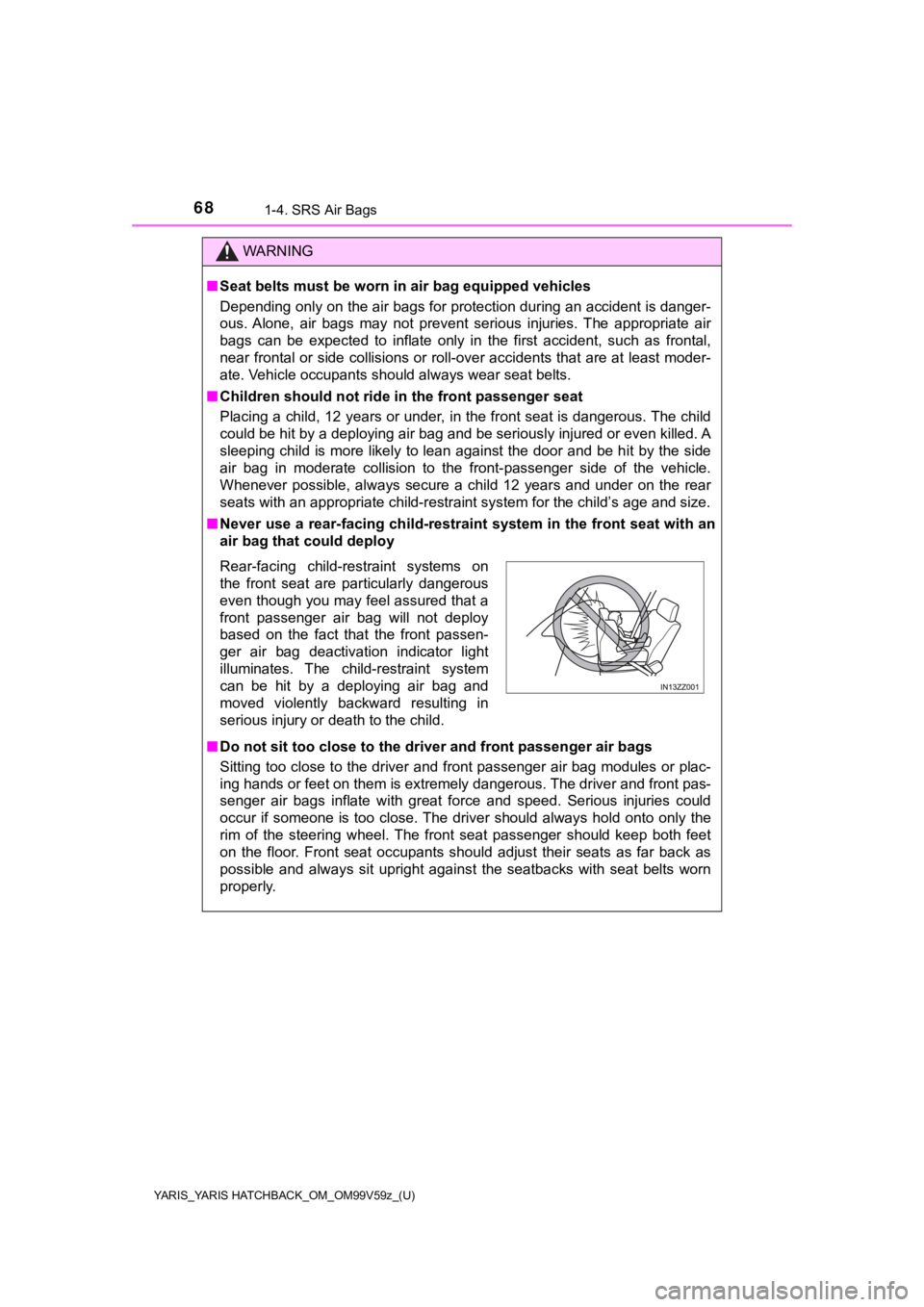
68
YARIS_YARIS HATCHBACK_OM_OM99V59z_(U)
1-4. SRS Air Bags
WARNING
■Seat belts must be worn in air bag equipped vehicles
Depending only on the air bags for protection during an acciden t is danger-
ous. Alone, air bags may not prevent serious injuries. The appr opriate air
bags can be expected to inflate only in the first accident, suc h as frontal,
near frontal or side collisions or roll-over accidents that are at least moder-
ate. Vehicle occupants should always wear seat belts.
■ Children should not ride in the front passenger seat
Placing a child, 12 years or under, in the front seat is danger ous. The child
could be hit by a deploying air bag and be seriously injured or even killed. A
sleeping child is more likely to lean against the door and be h it by the side
air bag in moderate collision to the front-passenger side of th e vehicle.
Whenever possible, always secure a child 12 years and under on the rear
seats with an appropriate child-restraint system for the child’s age and size.
■ Never use a rear-facing child-restraint system in the front sea t with an
air bag that could deploy
■ Do not sit too close to the driver and fron t passenger air bags
Sitting too close to the driver and front passenger air bag modules or plac-
ing hands or feet on them is extremely dangerous. The driver an d front pas-
senger air bags inflate with great force and speed. Serious injuries could
occur if someone is too close. The driver should always hold on to only the
rim of the steering wheel. The front seat passenger should keep both feet
on the floor. Front seat occupants should adjust their seats as far back as
possible and always sit upright against the seatbacks with seat belts worn
properly.
Rear-facing child-restraint systems on
the front seat are particularly dangerous
even though you may feel assured that a
front passenger air bag will not deploy
based on the fact that the front passen-
ger air bag deactivation indicator light
illuminates. The child-restraint system
can be hit by a deploying air bag and
moved violently backward resulting in
serious injury or death to the child.
Page 73 of 572
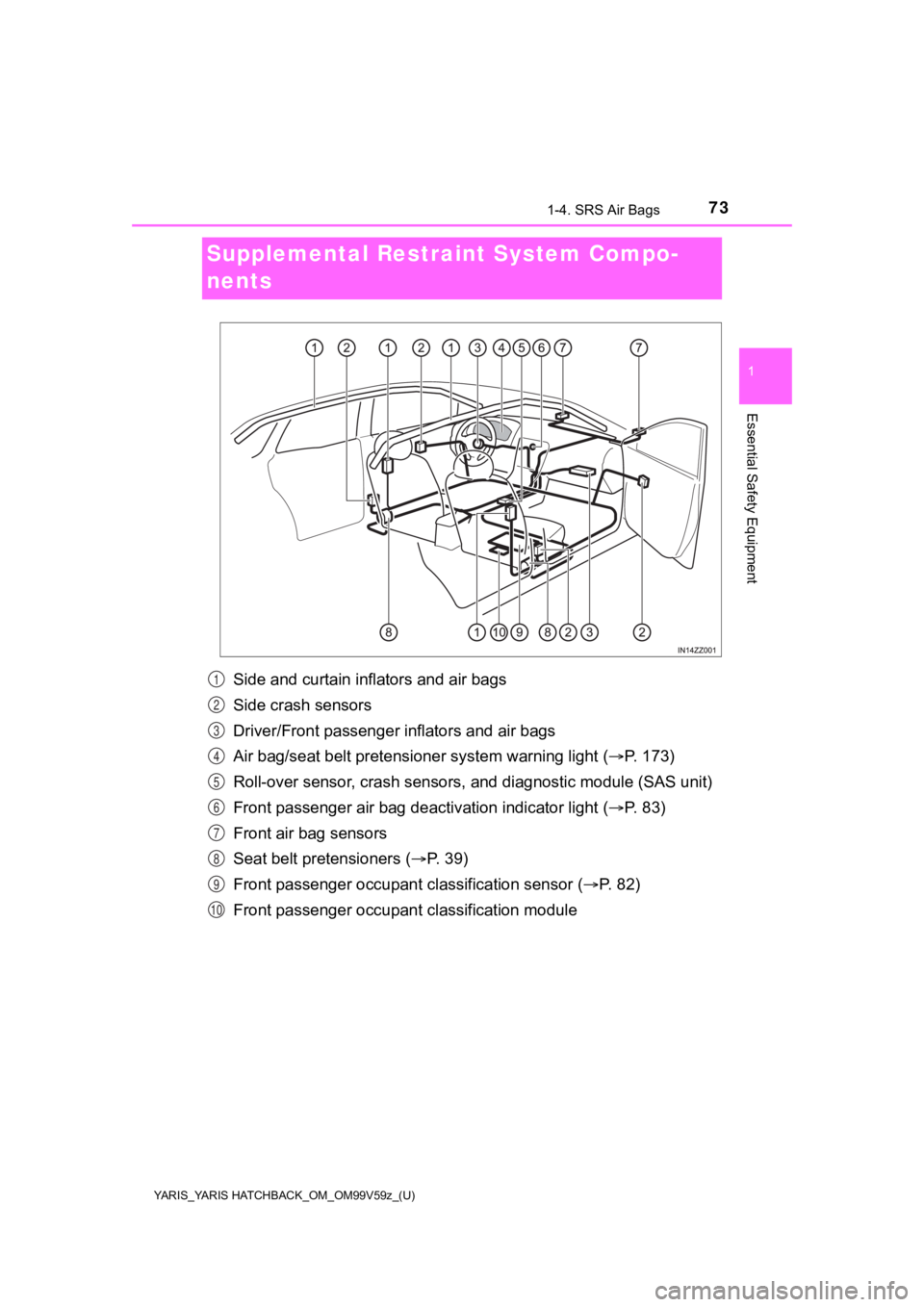
73
YARIS_YARIS HATCHBACK_OM_OM99V59z_(U)
1-4. SRS Air Bags
1
Essential Safety Equipment
Supplemental Restraint System Compo-
nents
Side and curtain inflators and air bags
Side crash sensors
Driver/Front passenger inflators and air bags
Air bag/seat belt pretensi oner system warning light ( P. 173)
Roll-over sensor, crash sensors, and diagnostic module (SAS uni t)
Front passenger air bag deac tivation indicator light (P. 8 3 )
Front air bag sensors
Seat belt pretensioners ( P. 3 9 )
Front passenger occupant c lassification sensor (P. 8 2 )
Front passenger occupant classification module1
2
3
4
5
6
7
8
9
10
Page 77 of 572

YARIS_YARIS HATCHBACK_OM_OM99V59z_(U)
771-4. SRS Air Bags
1
Essential Safety Equipment
◆Warning Light/Beep
A system malfunction or operation conditions are indicated by a
warning.
Refer to Warning/Indi cator Lights on P. 173.
Refer to Warning Sound i s Activated on P. 502.
Page 82 of 572
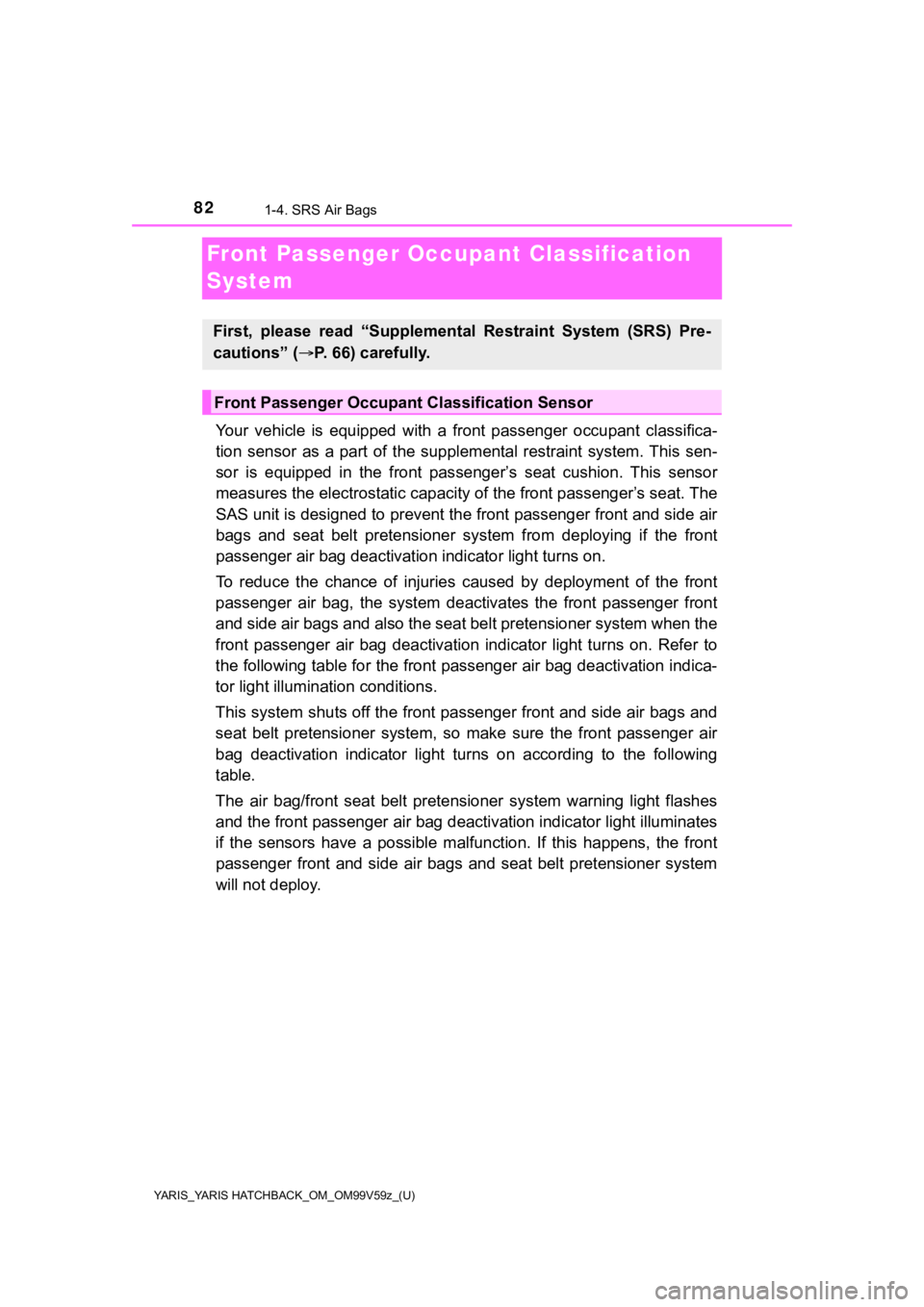
82
YARIS_YARIS HATCHBACK_OM_OM99V59z_(U)
1-4. SRS Air Bags
Front Passenger Occupant Classification
System
Your vehicle is equipped with a f ront passenger occupant classifica-
tion sensor as a part of the supplemental restraint system. Thi s sen-
sor is equipped in the front pas senger’s seat cushion. This sensor
measures the electrostatic capacity of the front passenger’s se at. The
SAS unit is designed to prevent the front passenger front and side air
bags and seat belt pretensioner system from deploying if the front
passenger air bag deactivation indicator light turns on.
To reduce the chance of injuries caused by deployment of the front
passenger air bag, the system deactivates the front passenger f ront
and side air bags and also the seat belt pretensioner system wh en the
front passenger air bag deactivat ion indicator light turns on. Refer to
the following table for the front passenger air bag deactivatio n indica-
tor light illumination conditions.
This system shuts off the front p assenger front and side air bags and
seat belt pretensioner system, s o make sure the front passenger air
bag deactivation indicator light turns on according to the foll owing
table.
The air bag/front seat belt pretensioner system warning light f lashes
and the front passenger air bag deactivation indicator light il luminates
if the sensors have a possible ma lfunction. If this happens, the front
passenger front and side air bags and seat belt pretensioner sy stem
will not deploy.
First, please read “Supplemental Restraint System (SRS) Pre-
cautions” ( P. 66) carefully.
Front Passenger Occupant Classification Sensor
Page 84 of 572

84
YARIS_YARIS HATCHBACK_OM_OM99V59z_(U)
1-4. SRS Air Bags
If the front passenger air bag deactivation indicator light does not
turn on when the ignition is swi tched ON and does not turn on a s
indicated in the front passenger air bag deactivation indicator light
on/off condition chart, do not allow an occupant to sit in the front
passenger seat and consult your Toyota dealer as soon as possi-
ble. The system may not wor k properly in an accident.
●The system requires about 10 seconds to alternate between turning the
front passenger front and side air bags and seat belt pretensio ner system on
or off.
● The front passenger air bag deactivation indicator light may tu rn on repeat-
edly if luggage or other items are put on the front passenger s eat, or if the
temperature of the vehicle’s interior changes suddenly.
● The front passenger air bag deactivation indicator light may tu rn on for 10
seconds if the electrostatic capacity on the front passenger se at changes.
● The air bag/front seat belt pretensioner system warning light might turn on if
the front passenger seat receives a severe impact.
● If the front passenger air bag deactivation indicator light doe s not turn on
after installing a child-restraint system on the front passenge r seat, first, re-
install your child-restraint system according to the procedure in this owner’s
manual. Then, if the front passenger air bag deactivation indic ator light still
does not turn on, install the child-restraint system on the rea r seat and con-
sult your Toyota dealer as soon as possible.
● If the front passenger air bag deactivation indicator light tur ns on when an
occupant is seated directly in the front passenger seat, have the passenger
re-adjust their posture by sitting with their feet on the floor , and then re-fas-
tening the seat belt. If the front passenger air bag deactivati on indicator light
remains turned on, move the passenger to the rear seat. If sitt ing in the rear
seat is not possible, slide the front passenger seat as far bac k as possible.
Consult your Toyota dealer as soon as possible.
Page 85 of 572
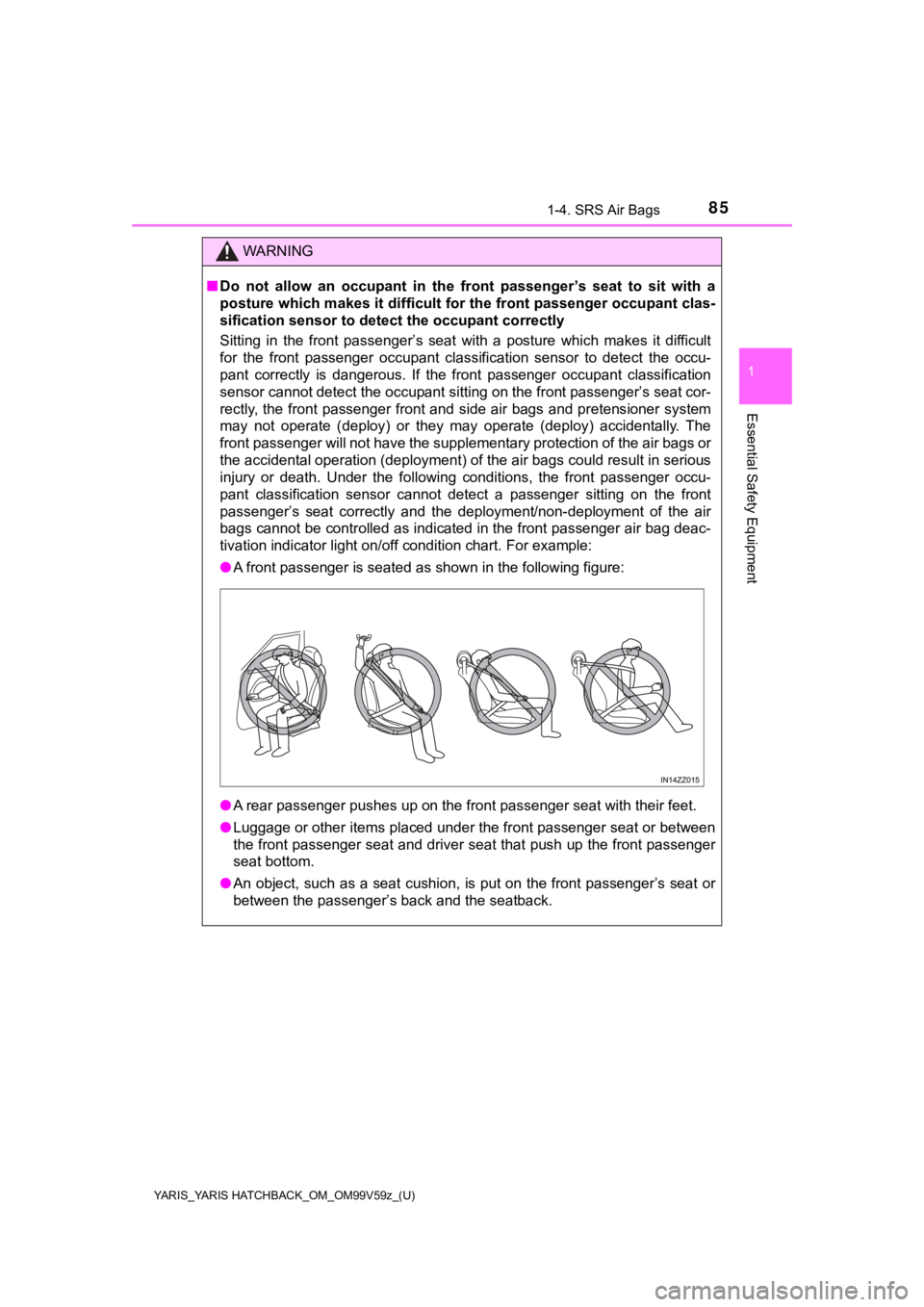
YARIS_YARIS HATCHBACK_OM_OM99V59z_(U)
851-4. SRS Air Bags
1
Essential Safety Equipment
WARNING
■Do not allow an occupant in the front passenger’s seat to sit w ith a
posture which makes it difficult for the front passenger occupa nt clas-
sification sensor to detect the occupant correctly
Sitting in the front passenger’s seat with a posture which make s it difficult
for the front passenger occupant classification sensor to detec t the occu-
pant correctly is dangerous. If the front passenger occupant classification
sensor cannot detect the occupant sitting on the front passenge r’s seat cor-
rectly, the front passenger front and side air bags and pretens ioner system
may not operate (deploy) or they may operate (deploy) accidenta lly. The
front passenger will not have the supplementary protection of t he air bags or
the accidental operation (deployment) of the air bags could res ult in serious
injury or death. Under the following conditions, the front pass enger occu-
pant classification sensor cannot detect a passenger sitting on the front
passenger’s seat correctly and the deployment/non-deployment of the air
bags cannot be controlled as indicated in the front passenger air bag deac-
tivation indicator light on/off condition chart. For example:
● A front passenger is seated as shown in the following figure:
● A rear passenger pushes up on the front passenger seat with their feet.
● Luggage or other items placed under the front passenger seat or between
the front passenger seat and driver seat that push up the front passenger
seat bottom.
● An object, such as a seat cushion, is put on the front passenge r’s seat or
between the passenger’s back and the seatback.
Page 86 of 572
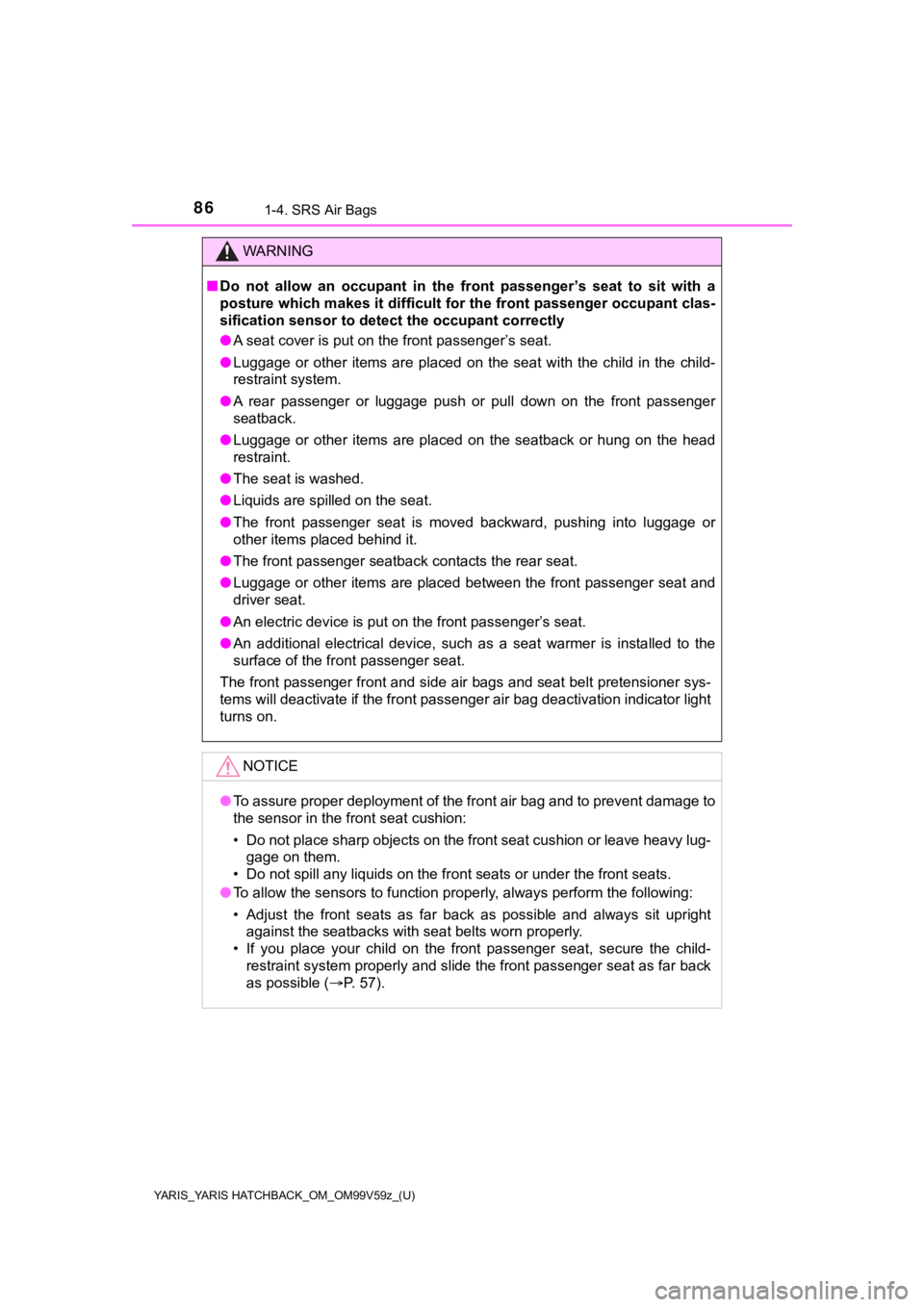
86
YARIS_YARIS HATCHBACK_OM_OM99V59z_(U)
1-4. SRS Air Bags
WARNING
■Do not allow an occupant in the front passenger’s seat to sit w ith a
posture which makes it difficult for the front passenger occupa nt clas-
sification sensor to detect the occupant correctly
● A seat cover is put on the front passenger’s seat.
● Luggage or other items are placed on the seat with the child in the child-
restraint system.
● A rear passenger or luggage push or pull down on the front pass enger
seatback.
● Luggage or other items are placed on the seatback or hung on the head
restraint.
● The seat is washed.
● Liquids are spilled on the seat.
● The front passenger seat is moved backward, pushing into luggag e or
other items placed behind it.
● The front passenger seatback contacts the rear seat.
● Luggage or other items are placed between the front passenger s eat and
driver seat.
● An electric device is put on the front passenger’s seat.
● An additional electrical device, such as a seat warmer is installed to the
surface of the front passenger seat.
The front passenger front and side air bags and seat belt prete nsioner sys-
tems will deactivate if the front passenger air bag deactivatio n indicator light
turns on.
NOTICE
● To assure proper deployment of the front air bag and to prevent damage to
the sensor in the front seat cushion:
• Do not place sharp objects on the front seat cushion or leave heavy lug-
gage on them.
• Do not spill any liquids on the front seats or under the front seats.
● To allow the sensors to function properly, always perform the f ollowing:
• Adjust the front seats as far back as possible and always sit upright
against the seatbacks with seat belts worn properly.
• If you place your child on the front passenger seat, secure th e child-
restraint system properly and slide the front passenger seat as far back
as possible ( P. 57).
Page 87 of 572

87
YARIS_YARIS HATCHBACK_OM_OM99V59z_(U)
1-4. SRS Air Bags
1
Essential Safety Equipment
Constant Monitoring
The following components of the air bag systems are monitored by a
diagnostic system: • Crash sensors, and diagnostic module (SAS unit)
• Front air bag sensors
• Air bag modules
• Side crash sensors
• Air bag/Front seat belt pret ensioner system warning light
• Front seat belt pretensioners
• Related wiring
• Front passenger air bag d eactivation indicator light
• Front passenger occupant classification sensor
• Front passenger occupant classification module
The diagnostic module continuously monitors the system’s readin ess.
This begins when the ignition is switched ON and continues whil e the
vehicle is being driven.
Page 91 of 572
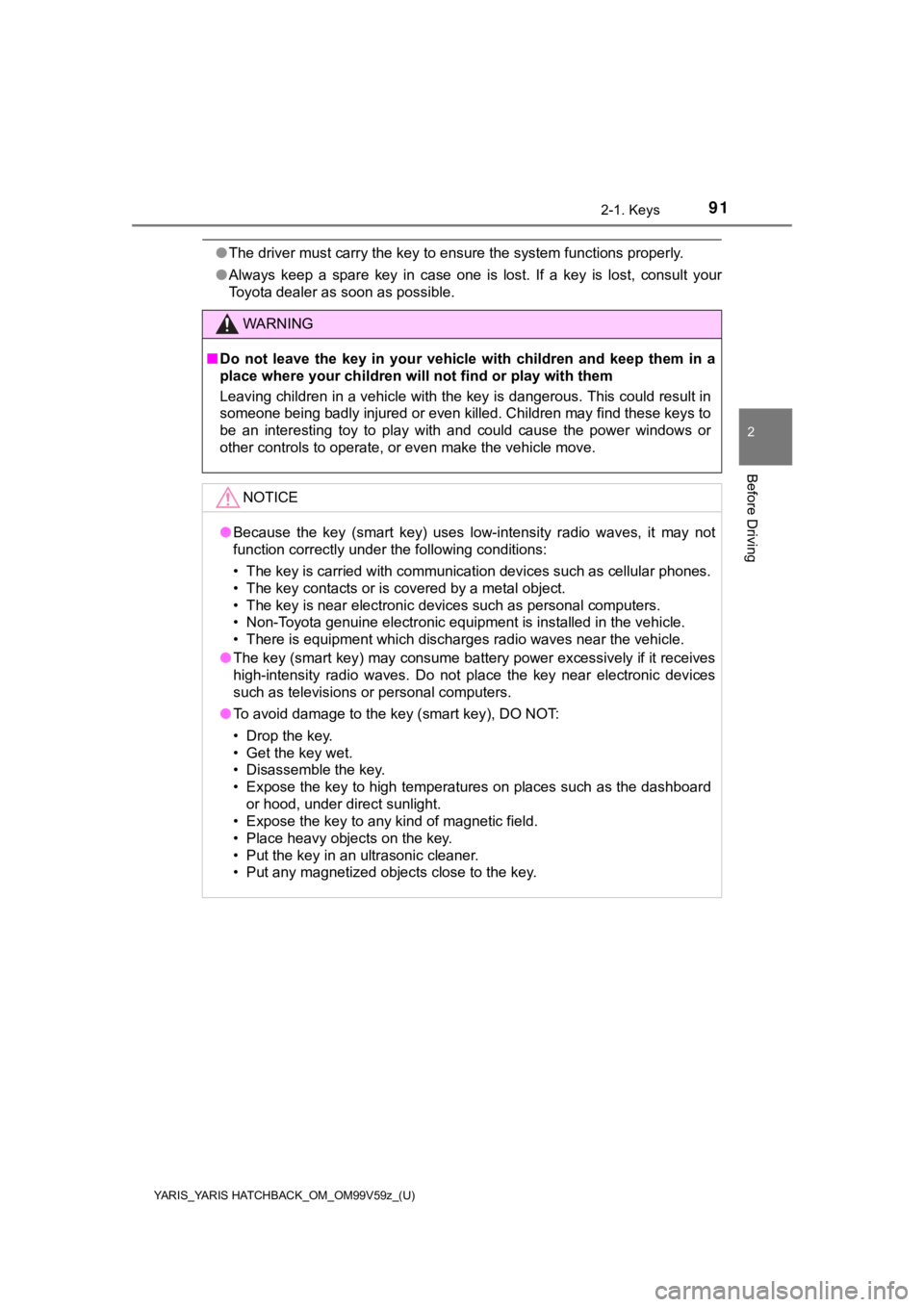
YARIS_YARIS HATCHBACK_OM_OM99V59z_(U)
912-1. Keys
2
Before Driving
●The driver must carry the key to ensure the system functions properly.
● Always keep a spare key in case one is lost. If a key is lost, consult your
Toyota dealer as soon as possible.
WARNING
■Do not leave the key in your vehi cle with children and keep them in a
place where your children will not find or play with them
Leaving children in a vehicle with the key is dangerous. This c ould result in
someone being badly injured or even killed. Children may find these keys to
be an interesting toy to play with and could cause the power wi ndows or
other controls to operate, or even make the vehicle move.
NOTICE
● Because the key (smart key) uses low-intensity radio waves, it may not
function correctly under the following conditions:
• The key is carried with communication devices such as cellular phones.
• The key contacts or is covered by a metal object.
• The key is near electronic devices such as personal computers.
• Non-Toyota genuine electronic equipment is installed in the ve hicle.
• There is equipment which discharges radio waves near the vehic le.
● The key (smart key) may consume battery power excessively if it receives
high-intensity radio waves. Do not place the key near electronic devices
such as televisions or personal computers.
● To avoid damage to the key (smart key), DO NOT:
• Drop the key.
• Get the key wet.
• Disassemble the key.
• Expose the key to high temperatures on places such as the dash board
or hood, under direct sunlight.
• Expose the key to any kind of magnetic field.
• Place heavy objects on the key.
• Put the key in an ultrasonic cleaner.
• Put any magnetized objects close to the key.